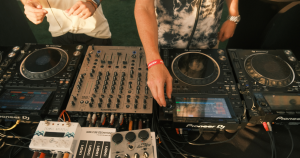When Larry Weintraub stepped into the CEO role at Beckett’s, he inherited a brand with enviable distribution. Yet it was only scratching the surface of what it could become.
In this conversation, Larry opens up about how he evaluated the opportunity, the early decisions that reshaped Beckett’s direction, and the operational realities of building a non-alcoholic brand at scale. He also shares where he believes the category is heading, and what it will take to win the next chapter.
Dry Atlas: As you considered the CEO role at Beckett’s, what indicators told you the brand had the potential to scale?
Larry Weintraub: Three things stood out right away:
First, the product was legitimately great. Admittedly, I hadn’t tried many non-alcoholic cocktails and didn’t have big expectations going in, but the taste blew me away.
Second, the brand already had momentum. All eight SKUs were in Total Wine & More stores nationwide, and were top performers in the category. That kind of distribution and repeat velocity is rare—and incredibly valuable—for an emerging brand. Beckett’s had a story to tell; it just hadn’t been told loudly enough yet.
Third, clear behavioral trends were emerging. After looking at the data, I could see that alcohol sales were slowing and the non-alcoholic category was growing. Consumers were drinking less, which presented a big opportunity. That tailwind—combined with a quality product and existing retail traction—felt like the perfect storm.
DA: What was your mandate when you first stepped into the role?
LW: Grow availability.
We had great traction at Total Wine across 29 states, but that only reaches part of the market. My job was to take that success and widen it with more chains, more independent retailers, and more on-premise accounts. Places where consumers could find and try Beckett’s.
DA: What were the first strategic gaps or opportunities you identified?
LW: The biggest gap was that we didn’t have a clear picture of who our customer was, or why they were choosing Beckett’s. We had sales, but not real insight.
My background is in marketing, so understanding the consumer is always my starting point. When I stepped in and asked basic questions (who buys us, and why), we didn’t have the answers yet.
The first move was to define the brand and get an answer to “Why Beckett’s?” We spent months talking to consumers and digging into the research until we understood who they are and what they value. That work reshaped everything.
The insights we gained also led to our tagline, “Too Good To Be Wasted.” I’m proud of it because it captures the double meaning we uncovered. It’s about our customers not wanting to waste their moments on subpar experiences, and it’s about us not wasting the opportunity to deliver something exceptional. And yes—there’s also the part about not wanting to be wasted.
Once you know who you’re for, the rest of the strategy falls into place.
DA: You came into a brand with an existing product line. What positioning changes have had the biggest impact on velocity or retailer traction?
LW: Eight SKUs can be a strength, but they can also overwhelm new retailers. They want to know what will sell. We dug into the data and identified our core four. It simplifies the conversation and reduces the risk for retailers.
Seasonality has also been a major lever. Our Margarita and Paloma RTDs take off in summer. Our Moscow Mule and Gin and Tonic RTDs perform better in cooler months. Matching our pitch to the season improves retailer buy-in and velocity.
For established partners like Total Wine, innovation keeps the brand moving. The new Margarita variety pack we introduced this year is a good example. It performed well on its own and lifted sales across the entire line.
DA: Which distribution channels have proven most effective for Beckett’s, and what expansion bets are you making for 2026?
LW: I imagine many brands who are Dry Atlas members started with independent shops or DTC. We came in the opposite direction. We were already in a major national retailer, but didn’t yet have those early community relationships. We’ve been building them from scratch.
Each channel plays a different role. Large chains like Total Wine give us the volume needed to scale. Independent retailers give us connection and real feedback. Shops like Burden of Proof in Pasadena took a chance on us, and that kind of support matters. DTC is financially tough, but it lets us test new items and see what people respond to.
For 2026, we’re investing in all three. We’re expanding our independent footprint with direct outreach to shops and bars that haven’t discovered us yet. We’re using our online channel as a testing ground for innovation. And we’re growing with more national chains where it makes sense. On-premise is a longer-term move, but it’s an important part of where we’re headed.
DA: How does Beckett’s think about repeat purchases, and what levers are you pulling to convert first-time trial into habit?
LW: We look at repeat in two ways: building real connection with the people who buy us, and creating as many trial moments as possible.
On the community side, we’ve given away a lot of product this year. We sent free 4-packs of Palomas and Margaritas over the summer and asked people to share with friends. Later, we did the same in exchange for feedback.
At retail, the biggest driver is still trial. Samplings, promos, and discounts work. Nothing beats watching someone try the product and say it tastes great. When I get to do the samplings myself and tell people I run the company, it’s even better.
DA: You have extensive experience in marketing and innovation. Which principles from your previous roles have proven most useful in steering Beckett’s?
LW: Most of my career has been focused on word-of-mouth marketing, and the biggest lesson I brought with me is to treat people with respect and make them feel valued. When customers or retailers feel heard, they come back—and they tell others about you.
It sounds basic, but it only works if you actually follow through. You can’t just talk about being customer-focused as a brand. You have to show it. If someone tells me they love our products, I do more than say thanks. I send personal notes, add small extras, and build real relationships.
It’s not the most scalable approach, but it creates something more powerful than any campaign. It creates evangelists.
DA: What are the most underappreciated operational challenges in running a non-alcoholic beverage company at scale today?
LW: There are so many! I joke that most of my career was spent selling air, whether it was music or marketing services. Moving into physical products has been a masterclass in complexity.
Getting a drink from idea to shelf is hard. Formulation, production, compliance, packaging, labeling rules, logistics, warehousing, distribution—every step has a handful of ways it can go wrong. I’ve learned more about supply chain in the past year than in the twenty before it.
Now when I walk into a store and see a canned mocktail or even a tube of toothpaste, I have a whole new level of respect for what it took to get it there. The operations side is challenging and definitely not glamorous, but it’s essential.
DA: What signals would tell you the category is entering its next phase of maturity? How is Beckett’s positioning for that shift?
LW: I’ve seen big category shifts before. I was in the music business when everything moved from physical formats to digital. It didn’t happen overnight, but the signs were obvious. The industry pushed back, but consumers had already changed.
I see a similar pattern in alcohol now. People want alternatives. The industry has been slow to adjust, but the consumer has already spoken. The shift is real and it’s speeding up.
For Beckett’s, we’re getting ready in a couple of ways. Our products are already strong, and we’ll keep improving them. Just as important, we’re building the data and sales stories that retailers and bars rely on. We track which SKUs move fastest, which seasonal patterns drive repeat purchases, and how we perform against benchmarks.
I like to say we’re building stories one at a time, and they’re starting to compound. When the category hits its next gear, we want to be one of the brands ready to scale with it.
DA: If you could drive one major strategic win for Beckett’s in the next 12 months, what would it be, and why does it matter most now?
LW: I want to win California. That means having Beckett’s available everywhere adult non-alcoholic drinks are sold or served across the state.
We’re based in Los Angeles, yet most of our early traction came from the Northeast, Florida, and Texas. During my first week on the job, I flew to Massachusetts to onboard a new distributor and spent three days riding with reps, going store to store. It was incredibly valuable. But when I got home, it hit me that I needed that same kind of ground game here, where our brand is based.
We’ve started that work. We have strong ties with some local independent shops, and I’ve built personal connections with dozens of bars, restaurants, nightclubs, and hotels across Southern California. But we are still early in the journey.
California matters strategically. It’s a huge state in both population and geography. If we can build wide availability here, it becomes a powerful proof point for the rest of the country. I talk a lot about storytelling, and the next story I want to tell is that we are everywhere in our home state.






